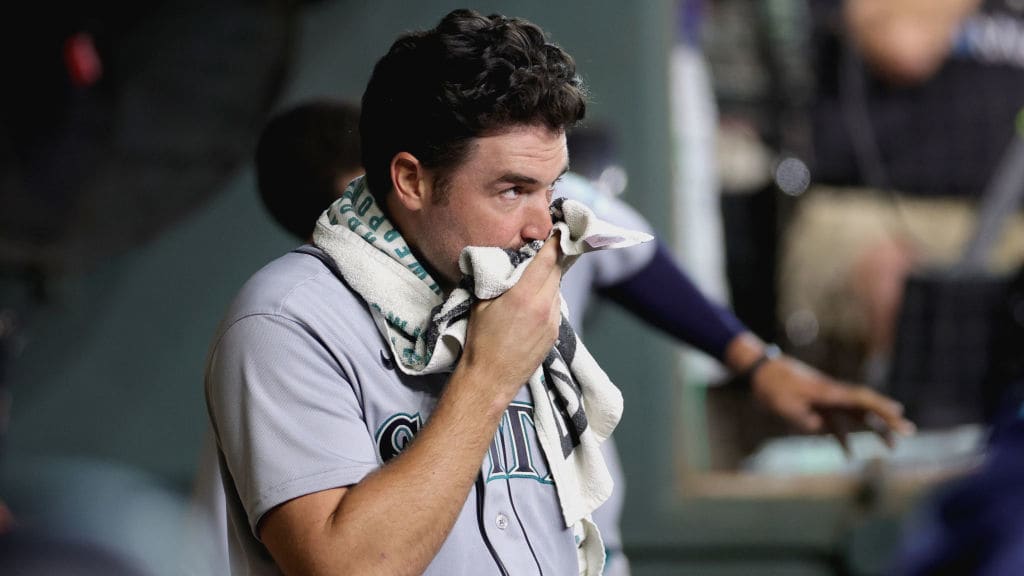
HOUSTON -- Things were spiraling for Robbie Ray, and he needed an answer. Quickly.
The two-pitch special that he rode to the AL Cy Young Award last year was simply not getting it done on Monday against a loaded Astros lineup, which teed off on three solo homers in the first two innings on Monday and drew another two walks. Ray was either right over the heart of the plate or nowhere near it with his four-seam fastball and slider combo.
So Mariners manager Scott Servais called a mid-inning consultation with Ray, catcher Cal Raleigh and pitching coach Pete Woodworth.
“They were not missing. A lot of pitches were right over the plate,” Servais said. “And after the first two innings, I was like, ‘OK, let's try something different.’ Sometimes I don't get involved in those conversations. [On Monday], I just grabbed him and said, ‘Hey, man, we’ve got to shake it up. I know you don't really have a definite Plan B. Let's make one up.'”
At Minute Maid Park, arguably the most hitter-friendly venue in the Majors, walks prove costly because the threat of a multi-run homer constantly looms. So Ray opted for a “new look” when he returned for the third inning. He dropped in a few changeups and curveballs, but the more notable selection was for a two-seam fastball (also classified as a sinker), which he completely replaced his four-seamer with the rest of the way.
The results: Houston went 3-for-8 against it with three singles, and of the 26 he threw, only one elicited a swing-and-miss. Those are hardly the trademark results for an arm that led the Majors with 248 strikeouts last year and has more than all but Max Scherzer, Gerrit Cole and Jacob deGrom since his first full season in 2015.
But the more telling result, in Ray’s estimation -- especially how things were going -- was that he was scoreless for three innings after the adjustment. Both fastballs have roughly the same velocity and spin (93 mph and 2,200 RPM range), but they break in different directions out of his left-handed arm slot.
“They were taking the slider below the zone. They weren't really chasing it," Ray said. "In the zone, it seemed like they hit it every time. So for me, I was just thinking if I get something to go that way instead of everything coming kind of inside to them, because they kind of seemed like they were just looking in. Like everything coming in, in, in. And so I just thought if I could get something going the other way, it might change the look. It might knock them off guard.”

Ray is among the rare starting pitchers who has thrived exclusively with two pitches. His logic: “If you throw two really good pitches, you should throw them as often as you can,” he said in Spring Training, despite starters typically needing multiple looks in order to keep hitters honest as they navigate multiple times through a lineup.
But baseball is all about adjustments, too, and Ray -- despite being the reigning Cy Young Award winner -- is no exception.
“I feel like the game has a four-to-five-year adjustment period,” Ray said. “I feel like it was maybe five, six years ago where it was kind of like the end of the sinkerball era. Guys started throwing four-seams at the top of the zone because hitters were staying on that. And now, we're seeing guys get on top of 101-102 mph fastballs at the top of the zone. ... Maybe guys are going to start working at the bottom of the zone again.”
Ray’s repertoire was far more diverse when he broke into the Majors, and he threw a two- and four-seam simultaneously up until 2016. But he ditched it when it wasn’t missing bats consistently.
“For me, it’s been more of a runner instead of a sinker," Ray said. "I get more horizontal movement than actual downward movement. So I think for me, it was still kind of staying in the zone. It wasn't really getting a lot of action on it. It was moving sideways, but guys could stay on it if they're looking out over it. Again, that could be just because I didn't really go in with the four-seam and then try to run the two-seam off. But that's kind of why I ditched it, because guys were kind of looking over for it and still hitting it because it wasn't getting a whole lot of action. It was just more running across the plate."
The two-seam installation on Monday wasn’t necessarily a seamless adjustment, as Ray lost control of one that tailed way inside to Kyle Tucker in the fifth, possibly a contributing factor in a benches-clearing argument later. There is admittedly still some feel to be regained in bullpen sessions between starts, but the two-seam’s debut on Monday might not be a one-time thing.
“Putting up three zeros with a pitch I haven't thrown in six years, it's definitely encouraging,” Ray said. “It shows how I'm able to adapt in a game and make decisions on the fly.”
